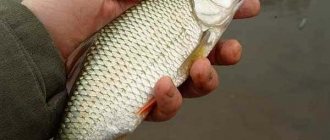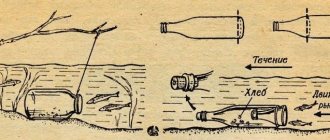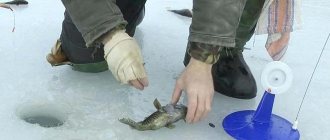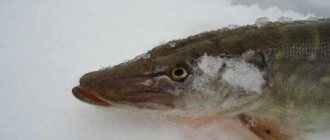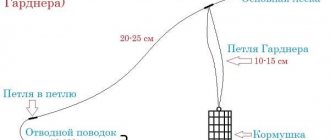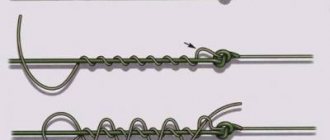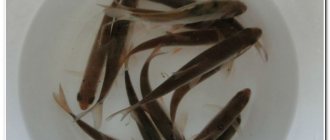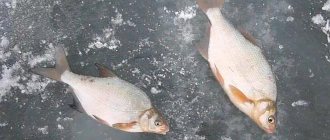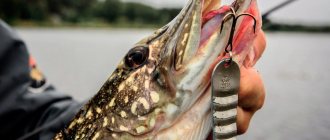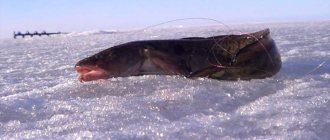What kind of live bait does pike prefer in winter?
In winter, pike behave differently, unlike days when it is warm outside and may not immediately swallow the bait, but keep it in their mouth for some time. The best bait for pike hunting is the fish that is found in the greatest quantity in a particular body of water and which the predator is accustomed to feeding on. For example, you can put any small fish on the girders. But the following fish are considered the best live bait for pike:
- perches;
- crucian carp;
- roach;
- rudd.
By studying the stomach contents of already caught fish, you can find out with almost 100% accuracy what the pike prefers at the moment and, based on this information, make the right choice of live bait.
It is impossible to say unequivocally what kind of baitfish the pike will like at one time or another, since each body of water has its own and each has its own advantages and disadvantages, which are discussed below.
Rotan
Live bait for pike: rotan
Rotan is a picky fish and bites at almost any time of the year. Rotan itself is a predatory fish. Whatever body of water it appears in, this predator displaces its inhabitants and quickly becomes the “owner” of the water territory. Many fishermen have a negative attitude towards rotan precisely for this quality, since it scares away other fish. But at the same time, its survivability and rapid adaptation to the conditions of detention are noted.
Many anglers are interested in whether catching pike with live bait in winter will be successful if they use rotan as live bait. Yes, but with some reservations. Rotan is quite suitable as live bait, but it is not recommended to use it in a reservoir where it did not live, since predators are accustomed to feeding on the fish that are found in their reservoir. If the pike where winter fishing will take place are familiar with this fish, then the catch with this live bait can be excellent. However, you need to make sure that the baited rotan cannot hide under stones or in thickets, since the first thing it tries to do is just that.
Perch
Perch is considered a durable and tenacious fish if you follow the rules when using it as bait. To make the bait last longer, do not thread the line through the gills or lip of the perch. If the gills are damaged, then very soon catching pike with live bait in winter will turn into hunting for dead bait. It should be noted that it is difficult to store caught perch at home, as they quickly die out. It is better to catch perch directly while fishing before fishing for pike.
Gudgeon
Gudgeon is a small but quite catchable bait for pike and is suitable for almost all types of predatory fish. This fish is found mainly in rivers and shallow reservoirs. They can be caught in any weather using a net and small worms. The gudgeon has the ability to dive to the very bottom, which will undoubtedly attract a predator.
About
All fishing methods
Catching methods:
- live bait rigs
- flashing
- balance
Please note the following points:
- The fishing rod must be really strong. Those that are used for catching perch or crucian carp are definitely not suitable, because... the pike will immediately break them. That's why we need stronger rods.
- The fishing line must be strong, but also elastic. It is preferable to use monofilament whose thickness ranges from 0.25 to 0.35 mm. Braided wire will not work in this case because it will freeze. A leash is required because the pike easily chews the fishing line. A durable metal cable is optimal. Its length must be more than 20 cm.
Zherlitsy
This is a passive form of pike fishing. It will require a regular plastic reel, fishing line, a sliding sinker of no more than 10 grams, a leash and a hook. All the equipment is located on the base in the form of a stand, a circle, etc., which hold the equipment at the required depth.
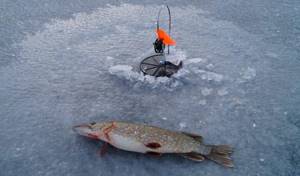
Read a detailed guide to catching pike with a jigging rod in the winter.
Before setting up this kind of setup (the second name is Zherlits), first decide on the fishing depth. Usually, for this purpose, a load weighing 50 grams is used, which is attached to the cork, to which the hook of the tackle is attached. The load is lowered into the hole, and then it rises 15-30 cm. This is fixed with a plate with a flag, then we pull out the fishing line with our hands. We remove the weight, bait with live bait and lower it into the hole again. Now you just need to wait for the bite and that’s it.
If the pike is not active and does not bite at all, try feeding the holes with homemade bait or winter bite activators .
Important: in most regions of the Russian Federation there is a strict limit on the number of girders per fisherman. Therefore, before fishing, make sure whether fishing with girders is allowed in the fishing region, as well as how many girders are allowed for fishing per fisherman.
A trap is one of the types of gear for catching pike. We do not encourage poaching methods such as this device and do not recommend using it in fishing. This is punishable by law.
Spoon
To catch this predator, both elongated lures for pike perch and pure pike lures are used - large, but not so long. The size of the bait varies - from 35 to 60 mm. The hook should be sharp, but it should not protrude excessively beyond the edge of the spoon, because On the contrary, this may scare away the predator.
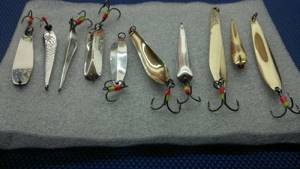
What color should the spinner be?
The color of the bait is selected depending on weather conditions. On a bright day, dim lures are preferred, on a cloudy day, bright ones. Pike are more active during thaws and on cloudy days.

The fishing process is simple. First you need to drill several holes, you don’t need to drill too far, at a distance of about 5 meters from each other. Then we gradually begin to fish the holes, starting from the first. The lure technique is simple: you need to lower the bait to the bottom, then raise it 4-6 cm above the bottom and begin to make sharp swings, during which the lure will “bounce” up 20-30 cm, and then gradually return to its previous position.
For live bait
When catching pike with live bait, place it behind your back.
This will make his movements in the water more natural. One fishing rod is used, which is equipped like a fishing rod, but a float or nod will be used as a bite alarm. With this fishing rod, you will need to go around hole after hole, and if a predator is standing under it, then the bite will occur as soon as you lower the bait. And then all that remains is to fish out the predator.
To the balancer
Fishing with a balance beam is similar to fishing with a spoon. True, the game with a balancer is somewhat different.
We drill a hole, lower the balancer (not to the bottom) and make the first short stroke. Now you need to wait until the balancer stops. If there are no hooks (i.e. vegetation, etc.), lower it even lower, check again - if there are no hooks, then lower it to the bottom and tap on it a little, swing the balancer a couple of times and pull it and the holes out.

If it is in the grass, then clean it and let the hole rest for a few minutes. Then we return it again and catch it a little higher than the grass, we also make swings, but with a greater amplitude. There is no need for it to go into a “tailspin”, because... For pike, the horizontal component of the game is important, regardless of depth. Usually this predator attacks the balance beam when rising, but in most cases, when falling or pausing. But it’s better not to take long pauses, because... The whole point is in the game of the balancer, its movement.
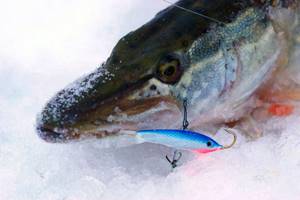
Watch a video about catching pike with a balance beam:
Catching pike with dead bait in winter
Experienced fishermen note that in many reservoirs, large pike often prefer dead bait, which lies motionless on the bottom, and do not chase live bait. If the water in the lake is cloudy, then the fish rely mainly on their sense of smell rather than their sight. Hunting for pike using dead bait has become the most preferred method for many anglers recently.
If you catch pike with large live bait, you should attach hooks to different parts of it, since otherwise the pike may eat the bait without reaching the hook.
It should be noted that whole small fish can be used as dead bait, but it is better to divide large fish in half. This method will allow you to quickly attract a predator due to the distribution of internal substances of the dead bait. In this case, it is better to cut the fish diagonally before putting it on the hook.
If a pike has caught a dead bait more than once, it may become suspicious and not swim up to the stationary fish. To do this, some fishermen use a trick by inflating the fish’s head with a syringe in advance or inserting a piece of foam into it. This will keep the head of the bait higher than the body and attract the attention of the predator.
For frozen capelin
Often, instead of live bait, frozen capelin is used for pike. This bait can be prepared in advance and for future use. One of the disadvantages of such bait is its immobility, to which pike rarely react. The movement of frozen live bait can only be achieved by the flow of the river, which is not always the case. However, the smell and unusual taste of capelin still attracts many predators, so many fishermen use this bait in the absence of live fish.
We make the vent ourselves
In the manufacture of girders, the cunning and ingenuity of domestic fishermen was especially evident. There are a considerable number of winter girders with various ingenious devices that signal the fisherman about a bite - with flags, flashing lights, “firing” pennants, sound signals, etc.
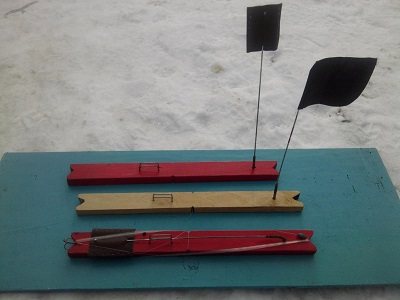
You can make the simplest ice reel from a plastic or wooden reel (usual “catfish hooks”), or with a screwed-on wooden bar that prevents the reel from being dragged into the hole (it is advisable to screw the bar movably, which is convenient when carrying).
A twig on which the fishing line is clamped is frozen next to the hole; 2-3 meters of unwound fishing line lie freely near the hole. As a signal beacon, you can use a piece of bright fabric firmly attached to the fishing line.
In order not to constantly be distracted by cleaning the hole from ice, experienced fishermen advise pouring a small amount of vegetable oil into it. But most fishermen don’t bother, but simply cover the hole with snow.
Since drilling holes, catching live bait and installing girders takes a lot of time and effort, which may not be enough to catch pike, it is very effective to combine the efforts of several anglers, with a clear division of labor - one drills, the other prepares girders, and so on.
What size should a live bait be for pike?
The size of pike that a fisherman intends to catch depends on the type of bait used. Accordingly, the larger the bait, the larger the fish you can catch. But don't overdo it. The best size for pike is considered to be a live bait size of 8-10 cm, but you can use smaller ones.
For large pike
Such fish, as a rule, are found in deeper reservoirs and are best caught with large live bait. The bait for large pike should be at least 10 cm in length. You can use larger fish, for example 20-25 cm. For large trophy-sized predators, you need really large live bait, for example crucian carp or roach weighing at least 200 grams. It should also be noted that it is better to catch a large predator using live bait than artificial bait.
About
Live bait fishing
Live bait for the girders is selected based on the preferences of the local predator. Fishermen in central Russia use roach, crucian carp and perch as live bait. A good bait for pike is the gudgeon; thanks to its endurance, it remains mobile for a long time.
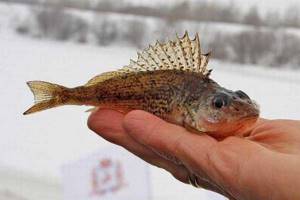
The ruff shows itself well. Bites on it are always correct; apparently, the predator perceives the swallowed hook as ruff thorns and does not spit it out of its mouth.
It’s better to get live bait in advance. They catch it using delicate winter tackle with a small jig. In January and February, at the height of the deep winter, sometimes you have to fish with very thin (0.05 - 0.06 mm) fishing lines and micro jigs. Live bait should not be too large; the optimal size is up to 10 cm. If you place live bait that is too large, false alarms will often occur.
“In spring, large pike respond well to small baitfish. At this time, her belly is full of caviar and it is difficult for her to digest the voluminous prey.”
Live bait should be stored in spacious containers. Periodically, he needs to change the water and feed him with bloodworms. It is necessary to avoid strong changes in water temperature - this is detrimental to fish. It is desirable that the temperature at the storage location and the fishing location be approximately the same.
What is the best live bait for pike in winter?
Many anglers believe that the best live bait for pike in winter are perch and roach. This is explained by the fact that pike attack these fish especially aggressively, and on a large river they are often the only live bait suitable for catching a predator.
Sometimes, when attacking a perch and clinging to a hook, a pike may think that these are its spines, and this is also convenient for the fisherman. In addition, the dense scales of the perch force the pike to hold it in its teeth longer without feeling the catch. These live baits are also distinguished by their special survivability at home, so they can be caught several days before pike hunting. In winter, perch can often be found closer to the shore, and roach in shallow water where there is a lot of vegetation.
Ideally, the best live bait for pike in winter is the one with which it is caught in a given body of water at the right time. Which one and what is better can only be determined experimentally.
Crucian carp and rotan as live bait
Concluding the discussion of the advantages and disadvantages of live bait, it is logical to say a few words about crucian carp and rotan.
Nowadays, catching crucian carp with a fishing rod is problematic. This can only be done in a reservoir where there are a lot of crucian carp and under a certain set of circumstances. Moreover, the work may be in vain, since in many reservoirs the predator does not favor crucian carp.
You also need to keep in mind that in the reservoirs near Moscow, where crucian carp come from for sale, all this fish is infected and can become a carrier of diseases that are not dangerous to humans, but all local crucian carp and carp will probably get sick.
My opinion is that it is possible to use crucian carp, sometimes even very effectively. But local live bait is always better.
A few words about rotan. There are reservoirs where neither perch, nor pike, nor large rotan avoid this fish. As a rule, these are old peat quarries. Preparing rotan for live bait does not present any difficulty, so this issue is not worth discussing.
Fishing rod equipment for catching perch for fry in winter
Monofilament is best suited as the main line when fishing for perch with fry. The optimal diameter is 0.15-0.2 mm. Such a fishing line, on the one hand, allows small bait fish to move actively, on the other hand, it somewhat restrains its activity. At the same time, if a high-quality monofilament with a good breaking load is used, it will withstand fishing for perch of any size.
A sinker can be used weighing about 2-3 g. It is better to place it 10-20 cm above the hook. Tees are well suited for rigging fishing rods; doubles and singles are less commonly used.
You can also install a leash: made of monofilament or fluorocarbon with a breaking load lower than that of the main line, or, if there is a high probability of a pike biting, made of steel or fluorocarbon with a thickness of 0.3 mm.
How to put live bait on a hook
There are many ways to hook live bait. The main thing is that he does not fall asleep and continues to move freely, attracting the predator with his natural behavior. Therefore, rough hooks and leashes should be avoided, while not forgetting about the strength of the gear, since you will be dealing with a strong and assertive predator.
- If there is a current, the fry is attached by the lips or nostrils, and for fishing in calm waters - by the back.
- The fry can be used both in thick snags and for fishing from the bottom. While bottom live baits are more suitable for fishing in mid-water and on a clean bottom.
Features of equipment for fishing with live bait
- To fish for whitebait, it is enough to use any trolling rod equipped with a 10 cm nod and a line with a cross section of 0.14-0.16 mm. There are many colorful jigs for whitebait fishing, but their main purpose is to deliver bait to the fishing spot. Therefore, you can choose an inconspicuous lead “drop” with a strong but thin hook No. 6 to avoid the fry from leaving.
- In each individual case, it is necessary to select a variant of playing with a jig, but the retrieve should not be fast, and frequent pauses must be made. It is better to do them on the bottom or above the bottom, since this is where the perch takes the bait well.
- Sometimes for a good bite, swinging the jig with the fry just above the bottom is enough. In the process of fishing, you often have to select the frequency and amplitude of oscillations. Despite constant experimentation, there is always the most successful version of the game.
- By lifting the jig from the bottom, you can always determine by the movements of the nod how active the fry is and whether it needs to be replaced with a fresh one.
